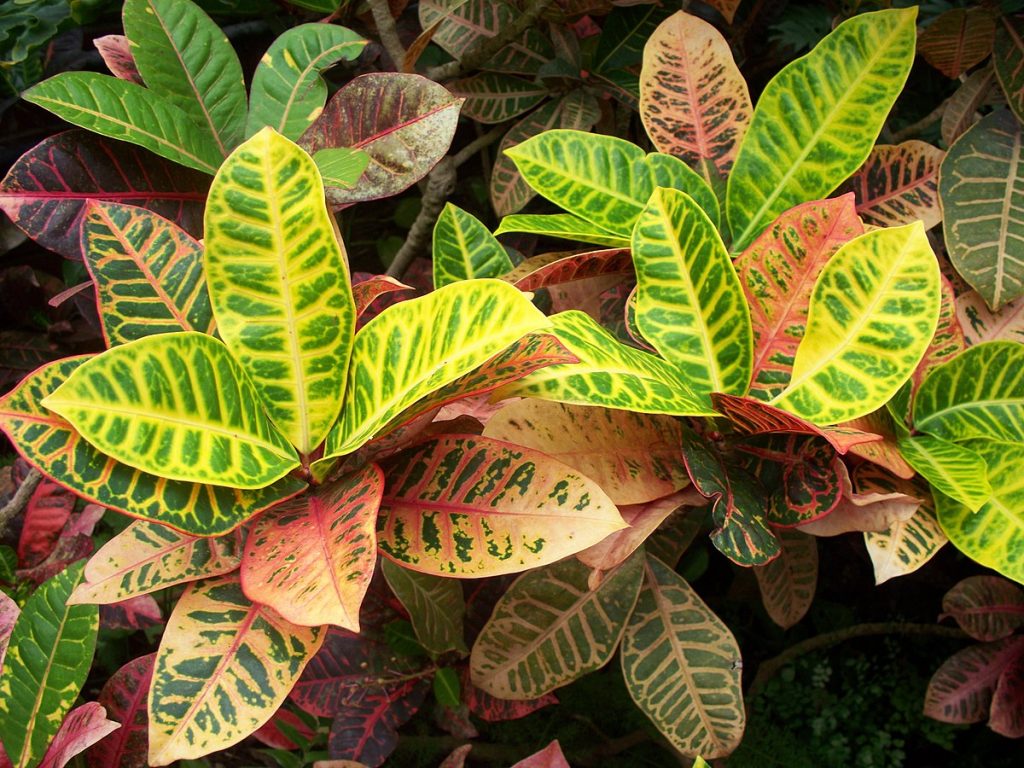
Native to open forests and scrub in tropical and subtropical Indonesia, Malaysia, Australia and the islands of the western Pacific Ocean, this tender evergreen shrub is a member of the spurge family, Euphorbiaceae, that also includes poinsettia, castor oil plant, and cassava. The plant can grow up to 12′ tall but is usually 3-6′ and forms of clump of stems that are green when young and turn brown and woody with age. The leaves are alternate, leathery, and shiny, but are variable in shape, color, and size. They are 2-12″ long, may be lanceolate, obovate, to violin-shaped, and may have entire, lobed, or undulating margins. The color varies from green to yellow, orange, red, pink, bronze, or purple may includes combinations of colors with blotches or spots, or veins and margins contrasting with the rest of the blade. Although potted plants do not bloom, those growing in soil produce slender axillary racemes of inconspicuous male and female flowers on different plants in spring or early autumn. The male flowers have 5 small white petals and 20-30 stamens while the female flowers lack petals and are yellowish. The fruit is a round tripartite capsule about 1/3″ in diameter and contains 3 small seeds. Croton is usually grown for its dramatic and colorful leaves as a container or accent plant but can be used as a hedge in warm climates. The milky sap in the stems and leaves may cause skin irritation and the leaves, stem, roots and seeds are considered poisonous to humans, dogs, and cats. The genus name, Codiaeum, comes from the Greek word kodeia or kodia, meaning head, head of plants, bulb, or capsule, and may refer to the fruit capsules, or leaves (being used for wreaths). The specific epithet, variegatum, comes from the Latin word variare, meaning to vary, and refers to the leaves.
Type: Evergreen tender shrub grown as an annual or houseplant
Outstanding Feature: Foliage
Form: Oval
Growth Rate: Slow
Bloom: Slender axillary raceme of inconspicuous male and female flowers on different plants
Size: 2-12 (but usually up 3- 6′)’ H x 2-6′ W
Light: Bright light; tolerates some shade but needs some sun to develop best color.
Soil: Fertile, medium moist, well-drained; high humidity
Hardiness: Zones 11-12
Care: Grow container plants in pebble tray to raise humidity.
Pests and Diseases: Generally healthy but susceptible to damage by thrips, scale, mealy bugs, and spider mites; root root in poorly drained soils
Propagation: Air-layering, cuttings
Outstanding Selections: Several hundred cultivars are available.
‘Andreanum’ (broadly oval yellow leaves with gold veins and margins)
‘Angustissimum’ (narrow leaves with yellow margins and ribs)
‘Aucubifolium’ (broad yellow, red-blotched leaves)
‘Aureo-maculatum’ (spotted yellow leaves)
‘Interruptum’ (sometimes twisted, yellow leaves with red midrib
‘Majesticum’ (pendulous branches, with linear leaves up to 10″ long with midrib veins yellow maturing to red)
‘Sanderi’ (broad leaves, irregularly blotched)
‘Spirale’ (spirally twisted red and green leaves)
‘Weismannii’ (narrow, wavy-margined leaves, variegated with yellow, red petiole)
var. pictum (probably not a distinct botanical variety)
Photo Credit: Cbaile19 Wikimedia Commons